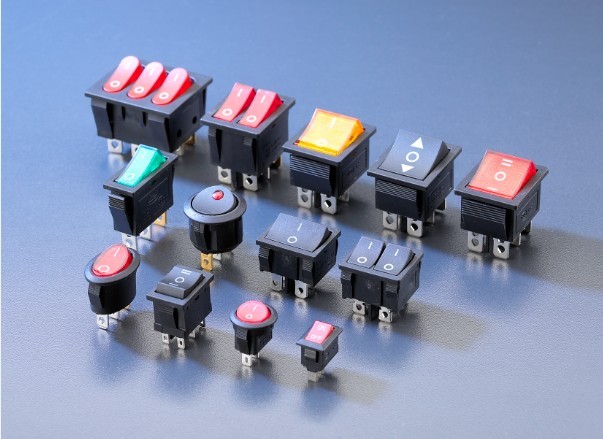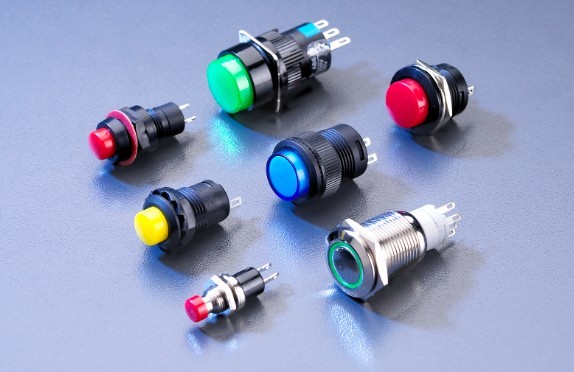When choosing switches for an electrical project or even simple home lighting, you might come across terms like rocker switch and momentary switch. At first glance, these can be confusing because they refer to different aspects of a switch’s design and function.
Whether you are a general consumer wiring a lamp or an electronics hobbyist building a circuit, it helps to understand what these terms mean.
In simple terms, a rocker switch is typically a kind of latching switch with a seesaw-like actuator that stays in position once toggled, while a momentary switch springs back to its default position after being pressed. This beginner-friendly guide will explain each type and highlight the key differences.

What Is a Rocker Switch?
A rocker switch is a type of switch that pivots in the middle, rocking back and forth like a seesaw. It usually has two stable positions, for example ON and OFF. When you press one side of a rocker switch, the other side pops up, and the switch stays in that position until toggled again.
In other words, most rocker switches latch into place. This means if you turn a rocker switch on, it will remain on until you flip it off. Because it stays in position, you can often tell by looking at the switch whether it is in the ON or OFF state, as the rocked position serves as a visual indicator.
Rocker switches are very common for power controls. For example, the main power switch on many appliances or power strips is a rocker. They are popular because of their straightforward operation and clear feedback. A rocker switch’s flat, wide surface is easy to press, and it often has a marking or LED to indicate when it is on.
In fact, rocker switches commonly serve as power switches for high-voltage circuits thanks to their robust build and clear on/off positions.
They can also be designed to resist dust or water with appropriate enclosures or IP ratings, making them suitable for a range of environments. If you see a large, flat switch that stays up or down after you press it, like many household wall light switches, it is likely a rocker switch in its latching form.
What Is a Momentary Switch?
A momentary switch is defined by its behaviour. It only stays active while you are pressing it. The moment you release it, the switch returns to its default resting position, usually off.
In other words, a momentary switch does not latch in the new state once you let go. This action is usually enabled by an internal spring or mechanism that pushes the switch back to its normal position when no longer pressed. The term “momentary” literally means it only maintains the closed circuit for a moment.
As a Panasonic guide explains, the switch remains ON only when its button is pressed and held, and returns to OFF as soon as it is released. Because of this self-resetting property, momentary switches are also called non-latching switches or spring-loaded switches.

Common examples of momentary switch actions are all around you. A classic example is a doorbell. It rings only while you press the button and stops when you let go. Another example is the keys on a keyboard or a phone touchscreen button, which only send a signal while pressed. Momentary switches often come in the form of push buttons, but they can also be toggles or rockers with spring return.
For instance, many car window switches are momentary rockers. You press and hold to move the window, and when you release, the switch springs back to centre and the window stops. In general, momentary switches are used for any function where you want a temporary connection.
They are widely used on intermittent input devices such as control keypads, machinery start buttons, or electric door controls that should only operate while being actuated.
By default, most momentary switches are designed as normally open, meaning they do not conduct until pressed. The key point is that once you remove pressure, a momentary switch reverts to its default state immediately.
Key Differences Between Rocker and Momentary Switches
When it comes to rocker vs. momentary switches, the core differences boil down to how they operate and how they are used. Below are the key differences explained:
Switch Action
A rocker switch typically uses a latching action. It stays in the new position after you flip it. This means the circuit remains open or closed until you actively flip the switch again. In contrast, a momentary switch is non-latching.
It only activates the circuit while you are pressing it, and then automatically returns to its original state when released. Latching switches have no return spring and lock into place, whereas momentary switches have a spring or mechanism that ensures they only stay active when pressed.
Physical Position and State Indication
A rocker switch remains in the up or down position where it was last left. Because of this, the position of the rocker itself gives a visual indication of the switch’s state. You can often tell at a glance if it is ON or OFF by seeing which side is pressed down.
A momentary switch, on the other hand, springs back to a neutral position after you use it. The switch does not stay depressed, so you cannot tell just by looking whether the circuit is active or not.
For example, a doorbell button looks the same whether the bell is ringing or not, since it returns to the same position. Any feedback about its state such as a light or a sound has to come from elsewhere, not the switch lever itself.
Design and Form Factor
The term rocker refers to a style of switch which describes the shape and how it pivots, while momentary refers to a functional mode of operation. These categories are not mutually exclusive. In fact, you can have momentary rocker switches as well as latching push button switches.
Rocker switches are usually thought of as the larger flat lever type common in UK wall light switches and appliance power switches that latch in position.
Momentary switches, meanwhile, can come in various designs such as push buttons, toggles, and even rocker-style actuators that can be made momentary by adding a spring return.
The difference is not in the external look alone, but in how the switch behaves. If a catalogue lists momentary or maintained for a given rocker switch, it is describing the function of that rocker style switch.
Typical Applications
Because rockers stay in one state until changed, they are ideal for functions where you want a continuous on or off state without having to hold the switch. For instance, lighting and power controls often use latching rockers.
Flip it on and the light stays on until you flip it off. This makes rockers well-suited for primary power switches, light switches, or any scenario where maintaining the state is desired.
Momentary switches, by contrast, excel in situations where a task should only occur while actively engaged. They are used for short-term or safety-related actions.
For example, a momentary switch might control a machine that only runs while a button is held down, to ensure it stops if you let go, or a car horn that honks only as long as you press it. In summary, latching rockers are great for toggling something on or off, whereas momentary switches are used for push and hold functions that require immediate cessation once released.
Internal Mechanism and Durability
The internal differences between these switches also lead to some practical considerations. A latching rocker switch relies on a locking mechanism or detent to stay in position, and it generally does not use a return spring.
In a momentary switch, there is typically a spring mechanism that pushes the actuator back to default when not pressed. Because of these extra parts, latching switches can be slightly more complex. A latching type often has more moving parts and can experience more wear over time due to friction in the locking parts.
Momentary switches, having fewer parts, tend to be mechanically simpler and may have a longer lifespan under frequent use. The difference is not huge, but if a switch will be pressed millions of times such as an arcade button, a momentary design might last longer under constant use.
In terms of cost, any difference is usually minor, but the added mechanism in latching switches can make them slightly more expensive than equivalent momentary switches. Still, both types are widely available at various price points, and the choice is more often about function than cost.
Conclusion
In summary, the difference between a rocker switch and a momentary switch comes down to how the switch operates and holds its state. Both types of switches can look quite similar externally, but their internal action sets them apart. By understanding these differences, you can choose the right switch for your needs.
This helps you keep a device powered on or trigger a function only on demand and ensures your project or household appliance works as intended.
 +86 138-6870-3133
+86 138-6870-3133 sales@lanzmfg.com
sales@lanzmfg.com EN
EN CN
CN Search
Search